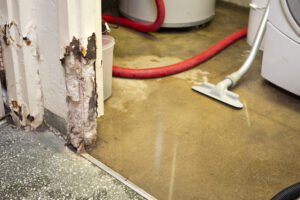How to Tell if a Basement Had Water Damage

Water in a basement is a serious problem. Whether it’s standing water or just overall dampness, basement moisture can damage your belongings and diminish your home’s air quality. Worse, basement water damage often means there’s water damage to the foundation, which can lead to structural problems in your home. How do you know if your basement has been subjected to water damage? Here are some tell-tale signs.
- Puddles of standing water: If there’s water on the floor of your basement, it could indicate a leak from your plumbing or an appliance. However, it could also be water that’s come in from outside, whether through your basement windows and entrances or through cracks, joints, or porous concrete.
- Damp air and musty smells: So many basements smell musty that many people think that’s a normal basement smell. In fact, it’s a sign of excess moisture and mold growth. This can be caused by leaks or malfunctioning sump pumps. If you notice water stains or condensation on the walls, discolored drywall, or white mineral deposits, that means water is getting into the basement.
- Mold or mildew: Aside from a musty smell, mold can leave stains on the walls, carpeting, furniture, and stored items. Both mold and mildew flourish when high humidity meets organic materials, and they can cause allergic reactions as well as other negative effects.
- Cracks or crumbling: If water has caused cracks in your foundation, those cracks can allow water to seep into the basement. Some cracks in the basement are not a big problem, but horizontal cracks are usually caused by hydrostatic pressure, which requires professional foundation repair.
- Efflorescence: When excess moisture moving through the walls and floor of the basement evaporates, it leaves behind white chalky stains called efflorescence, caused by mineral deposits. This in itself isn’t harmful, but while you can clean off efflorescence, it’s more important to get to the root of the problem.
- Flaking or peeling paint: Excess moisture causes peeling paint, and this is usually the result of rain, snowmelt, and groundwater getting into the basement. This could be because of cracks in the foundation or landscaping that’s not directing water far enough away from the house. Peeling paint can also be the result of leaking or sweating pipes.
- Wood rot: One of the most serious symptoms of a wet basement is wood rot, which can lead to structural damage. Even if you don’t see rotten wood, a bouncy or uneven floor over the basement can indicate rotten or damaged floor joists or sill plates.
- Problems with the floor or carpet. If your basement floor is sinking or uneven or your carpet is damp or stained, you have a water problem. Another sign that you need professional assistance is wet or stained drywall.
Fortunately, there are some steps you can take to keep water out of your basement. First, seal any cracks you notice in the basement or foundation. Then, make sure your landscaping, gutters, and landscaping all work together to direct water away from your house. Ultimately, the best way to ensure a dry basement is to call for help from an expert basement waterproofing company.
If you need help keeping your basement dry, trust Reliable Basement Services to make the process hassle-free. A family-owned and operated company, we’ve served the greater Chicago area for over a decade. We offer a full spectrum of basement services including crack repairs, sump pump systems, basement waterproofing, basement windows, and floor repair. Our consistently high standards have made us an award-winning Chicago basement waterproofing contractor, so call us at (630) 777-0539 or visit our website.
